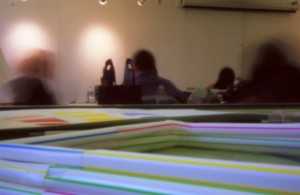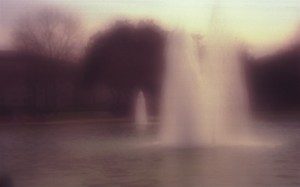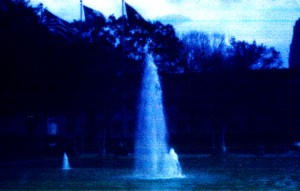But for some reason I am not. I have a busy day ahead tomorrow as I begin to build the next project for my Color Theory course. I’ll have more details on that one later. For now, however, let’s stick with the photography.
In my Primitive Photography course we have done 1 project so far and that was on photograms. Basically, a photogram is a photograph where, instead of a camera being used to capture an image, an object (or objects) is placed between the light and the photographic paper. The paper is exposed and processed with the resilt being an image (usually a silhouette of the object) on the paper. In short, as long as a camera was not used to create the photograph, then it can be called a photogram. My classmates came up with some really nice photograms, which put mine to shame. I will post them as soon as I get them back to my house for scanning.
We have moved on to a project on pinhole photography. We were given the task of constructing a pinhole camera and testing the exposure time. I know that part of this doesn’t sound too primitive, but pinhole photography was an extension of the camera obsure, which was widely used in medieval and Rennaissance Europe as a source of entertainment and sketching. As I already have a pinhole optic for my Lensbaby (and the instructorsaid I could use it), I spent the day prior to class shooting up a roll of film with both the pinhole and f/19 zone plate. I spent a good amount of time trying to fill 31 frames with photos, but in the end I think I got some good ones. The following 2 photos are my favorites from the pinhole and zone plate categories.
This is an example of a pinhole photograph. One of the first things one can notice about these is the (relative) sharpness is even throughout the depth of the scene. The straws were right up against the camera, which was in the rear half of a very large classroom. The uniform sharpness is due to the fact that the aperture for this pinhole is f/177, which pretty much eliminates depth-of-field considerations. Of course, with such a narrow opening, the exposure times will be long, and in this case I believe it was about 4 seconds. I really need to remember to write these things down sometimes.
A zone plate is basically a hole containing a set of radially symmetric rings that alternate between opaque and transparent. These rings then cause the light to diffract (scatter), rather than refract (bend) such as is done with a lens. The zones can be spaced as to cause the diffracted light to interfere with the focus, which in photography is often the desired application of zone plate optics. Above is an example of a photograph taken with the zone plate optic for my Lensbaby. While there is some detail, the focus is very blurry, especially around the edges of the elements in the photograph. Most of the lack of detail is due to the scene being backlit, but here is was necessary to highlight the fountains. The zone plate itself is f/19, which is a much bigger hole than the pinhole. The exposure time on this particular photo was 1/45 of a second.
Of course, long exposures do have their issues. In digital photography we all know that noise can build up to unacceptable levels during the course of a long exposure. Film photography has its own issue known as reciprocity failure. Basically, in black and white film the silver salts start to lose responsiveness during long exposures with low intensity light. In color film the different colored layers will start to unevenly absorb the light coming in, resulting in low density negatives. One basically ends up with a very thin negative that may or may not have a latent image inside. The image below is one example of reciprocity failure:
Notice the very deep shadows, even after digital processing of the image in order to bring forth some whites in an attempt to salvage it. In the initial scan the image was blue, so I left that color in place in order to highlight the issue. On this particular roll I had 2 reciprocity failures, which is 2 more than I can ever remember having before. This is obviously going to be an issue with a lot of students on this project, so we will see where this goes.
As for me, I’m starting to learn a little more about film. I have to do a little more research because I would like to build a “button cam” before Tuesday, but we will see how time permits. As for you all, I bid you goodnight.



Leave a Reply